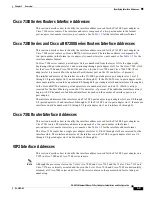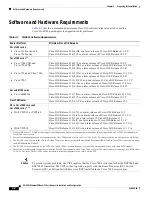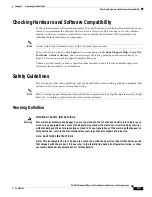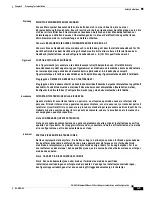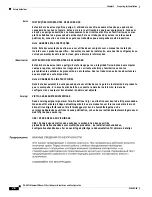
1-2
PA-5EFL Ethernet 10Base-FL Port Adapter Installation and Configuration
OL-3495-02
Chapter 1 Overview
IEEE 802.3 10Base-FL Specifications
changes. Together, Ethernet and IEEE 802.3 are the most widely used LAN protocols. They are well
suited to applications where a local communication medium must carry sporadic, occasionally heavy
traffic at high-peak data rates.
The term 10Base-FL is an abbreviation for 10 Mbps transmission, Baseband medium, F for fiber, and L
for link, as defined in the 10Base-FL specification. The Ethernet specifications call the 5EFL device a
transceiver, and it is connected to the station with a transceiver cable. The PA-5EFL is not an end
station. The IEEE 802.3 specifications refer to the same type of device as a media attachment unit
(MAU). Stations on a CSMA/CD LAN can access the network at any time. Before sending data, the
station listens to the network to see of it is already in use. If it is, the station waits until the network is
not in use, and then transmits. A collision occurs when two stations listen for network traffic, hear none,
and transmit simultaneously. When this happens, both transmissions are damaged, and the stations must
retransmit. The stations detect the collision and use backoff algorithms to determine when they should
retransmit.
Both Ethernet and IEEE 802.3 are broadcast networks, which means that all stations see all
transmissions. Each station must examine received frames to determine whether it is the intended
destination and, if it is, pass the frame to a higher protocol layer for processing. IEEE 802.3 specifies
several different physical layers, and Ethernet defines only one. Each IEEE 802.3 physical layer protocol
has a name that summarizes its characteristics in the format speed/signaling method/segment length
where speed is the LAN speed in Mbps, signaling method is the signaling method used (either baseband
or broadband), and segment length is the maximum length between stations in hundreds of meters. The
maximum distances for Ethernet network segments and connections depend on the type of transmission
cable used; for example, fiber-optic cable (10Base-FL).
IEEE 802.3 10Base-FL Specifications
Table 1-1 summarizes the characteristics of IEEE 802.3 Ethernet and Ethernet 10Base-FL.
Table 1-2 lists the distance limitations for 10-Mbps transmission over multimode optical-fiber cables.
Table 1-1
IEEE 802.3 Ethernet and Ethernet 10Base-Fl Physical Characteristics
Parameter
IEEE 802.3 Ethernet
10Base-FL Ethernet
Data rate (Mbps)
10
10
Signaling method
Baseband
Baseband
Media
50-ohm coax (thick)
Multimode optical fiber
Topology
Bus
Star
Table 1-2
Cable Distance Limitations for 10-Mbps 10Base-FL Transmission
Parameter
ST Connections
Cable specification
Multimode fiber-optic cable
1
1.
Cisco Systems does not supply fiber-optic cables; these cables are available commercially.
Maximum segment lengths
400 m (1,312 ft) for any repeater-to-DTE fiber segment
500 m (1,640 ft) with four repeaters and five segments
1000 m (3,280 ft) for any interrepeater fiber segment
2km (6,561 ft) without a repeater





















